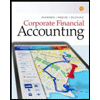
FUND ACCOUNTING PRINCIPLES CONNECT
25th Edition
ISBN: 9781265342395
Author: Wild
Publisher: MCG
expand_more
expand_more
format_list_bulleted
Question
Chapter 10, Problem 21QS
1.
To determine
Concept Introduction: Total asset turnover measures a company’s ability to use its asset to generate revenue. It is also used to analyze how efficiently the company has used its assets. Total asset turnover is calculated by dividing net sales by average total assets.
The total assets turnover for year 2.
2.
To determine
Concept Introduction: Total asset turnover measures a company’s ability to use its asset to generate revenue. It is also used to analyze how efficiently the company has used its assets. Total asset turnover is calculated by dividing net sales by average total assets.
The comparison of A’s total asset turnover with its competitor.
Expert Solution & Answer
Want to see the full answer?
Check out a sample textbook solution
Students have asked these similar questions
don't give me incorrect solution
I mistakenly submitted blurr image please comment i will write values.
please dont Solve with incorrect values otherwise unhelpful.
Can you help me solve this general accounting problem using the correct accounting process?
Chapter 10 Solutions
FUND ACCOUNTING PRINCIPLES CONNECT
Ch. 10 - Cost of plant assets C1 Kegler Bowling installs...Ch. 10 - Assigning costs to plant assets C1 Q Listed below...Ch. 10 - Prob. 3QSCh. 10 - Straight-line depreciation P1 On January 1= the...Ch. 10 - QS 10-' Units-of-production depreciation
On...Ch. 10 - QS10-5 Double-declining-balance method P1
A...Ch. 10 - Prob. 7QSCh. 10 - Prob. 8QSCh. 10 - Prob. 9QSCh. 10 - Prob. 10QS
Ch. 10 - Prob. 11QSCh. 10 - Prob. 12QSCh. 10 - Prob. 13QSCh. 10 - Prob. 14QSCh. 10 - Prob. 15QSCh. 10 - Prob. 16QSCh. 10 - Prob. 17QSCh. 10 - Prob. 18QSCh. 10 - Prob. 19QSCh. 10 - Prob. 20QSCh. 10 - Prob. 21QSCh. 10 - Prob. 22QSCh. 10 - Exercise 10-1 Cost of plant assets C1 Q Rizio Co....Ch. 10 - Prob. 2ECh. 10 - Prob. 3ECh. 10 - Exercise 104 Straight-line depreciation P1 Ramirez...Ch. 10 - Exercise 10-5 Units-of-production depreciation P1...Ch. 10 - Exercise 10-6
Double-declining-balance...Ch. 10 - Exercise 10-7 Straight-line depreciation P1
New...Ch. 10 - Exercise 10-8 Double-declining-balance...Ch. 10 - Exercise 10-9 Straight-line depreciation and...Ch. 10 - Exercise 10-10
Double-declining-balance...Ch. 10 - Exercise 10-11 Straight-line, partial-year...Ch. 10 - Exercise 10-12 Dauble-declining-balance....Ch. 10 - Exercise 10-13
Revising depreciation
C2
Apex...Ch. 10 - Exercise 10-14 Ordinary repairs, extraordinary...Ch. 10 - Exercise 10.15 Extraordinary repairs; plant asset...Ch. 10 - Exercise 10-16 Disposal of assets P2 Diaz Company...Ch. 10 - Exercise 10-17 Partial-year depreciation: disposal...Ch. 10 - Exercise 10-18 Depletion of natural resources P3...Ch. 10 - Exercise 10-19 Amortization of intangible assets...Ch. 10 - Exercise 10-20 Goodwill P4 Robinson Company...Ch. 10 - Exercise 10-21 Preparing a balance sheet P1 P3...Ch. 10 - Exercise 10-22 Evaluating efficient use of assets...Ch. 10 - Exercise 10-23A Exchanging assets P5
Gilly...Ch. 10 - Prob. 24ECh. 10 - Prob. 25ECh. 10 - Prob. 26ECh. 10 - Problem 10-1A Plant asset costs; depreciation...Ch. 10 - Problem 1O-2A Depreciation methods P1 A machine...Ch. 10 - Problem 10-3A Asset cost allocation; straight-line...Ch. 10 - Problem 10-4A
Computing and revising depreciation;...Ch. 10 - Problem 10-5A Computing and revising depreciation;...Ch. 10 - Problem 1O-6A
Disposal of plant assets
C1 P1...Ch. 10 - Problem 1O7A
Natural resources
P3
On July 23 of...Ch. 10 - Problem 10-1B Plant asset costs; depreciation...Ch. 10 - Problem 10-28 Depreciation methods P1 On January...Ch. 10 - Problem 10-3B Asset cost allocation; straight-line...Ch. 10 - Prob. 4PSBCh. 10 - Problem 10-5B Computing and revising...Ch. 10 - Problem 1O-6B
Disposal of plant assets
C1 P1 P2
On...Ch. 10 - Prob. 7PSBCh. 10 - Prob. 10SPCh. 10 - Prob. 1AACh. 10 - Prob. 2AACh. 10 - Prob. 3AACh. 10 - Prob. 1DQCh. 10 - Prob. 2DQCh. 10 - Prob. 3DQCh. 10 - Prob. 4DQCh. 10 - Prob. 5DQCh. 10 - Prob. 6DQCh. 10 - Prob. 7DQCh. 10 - Prob. 8DQCh. 10 - Prob. 9DQCh. 10 - Prob. 10DQCh. 10 - Prob. 11DQCh. 10 - Prob. 12DQCh. 10 - Prob. 13DQCh. 10 - Prob. 14DQCh. 10 - Prob. 15DQCh. 10 - Prob. 16DQCh. 10 - Prob. 1BTNCh. 10 - Prob. 2BTNCh. 10 - Prob. 3BTNCh. 10 - Prob. 4BTN
Knowledge Booster
Similar questions
- On March 1, 20X1, your company,which uses Units-of-Production (UOP) Depreciation, purchases a machine for $300,000.arrow_forwardPlease provide the accurate answer to this general accounting problem using valid techniques.arrow_forwardI am searching for the right answer to this financial accounting question using proper techniques.arrow_forward
- Please explain the solution to this general accounting problem with accurate principles.arrow_forwardI am searching for the correct answer to this general accounting problem with proper accounting rules.arrow_forwardi will give unhelpful.blurr image please comment i will write values. please dont Solve with incorrect values otherwise unhelpful.arrow_forward
arrow_back_ios
SEE MORE QUESTIONS
arrow_forward_ios
Recommended textbooks for you
 Cornerstones of Financial AccountingAccountingISBN:9781337690881Author:Jay Rich, Jeff JonesPublisher:Cengage Learning
Cornerstones of Financial AccountingAccountingISBN:9781337690881Author:Jay Rich, Jeff JonesPublisher:Cengage Learning Survey of Accounting (Accounting I)AccountingISBN:9781305961883Author:Carl WarrenPublisher:Cengage Learning
Survey of Accounting (Accounting I)AccountingISBN:9781305961883Author:Carl WarrenPublisher:Cengage Learning Financial And Managerial AccountingAccountingISBN:9781337902663Author:WARREN, Carl S.Publisher:Cengage Learning,
Financial And Managerial AccountingAccountingISBN:9781337902663Author:WARREN, Carl S.Publisher:Cengage Learning, Corporate Financial AccountingAccountingISBN:9781305653535Author:Carl Warren, James M. Reeve, Jonathan DuchacPublisher:Cengage Learning
Corporate Financial AccountingAccountingISBN:9781305653535Author:Carl Warren, James M. Reeve, Jonathan DuchacPublisher:Cengage Learning

Cornerstones of Financial Accounting
Accounting
ISBN:9781337690881
Author:Jay Rich, Jeff Jones
Publisher:Cengage Learning

Survey of Accounting (Accounting I)
Accounting
ISBN:9781305961883
Author:Carl Warren
Publisher:Cengage Learning

Financial And Managerial Accounting
Accounting
ISBN:9781337902663
Author:WARREN, Carl S.
Publisher:Cengage Learning,

Corporate Financial Accounting
Accounting
ISBN:9781305653535
Author:Carl Warren, James M. Reeve, Jonathan Duchac
Publisher:Cengage Learning